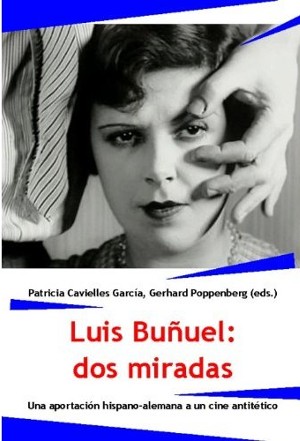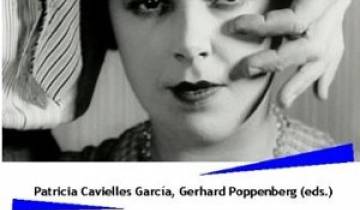Luis Buñuel: two glances

A Spanish-German contribution to an antithetical cinema
Patricia Cavielles García and Gerhard Poppenberg, editors
Edition Tram. Verlag Walter Frey. Berlin 2011
The book "Luis Buñuel: two looks" is the result of the intercultural conference "Luis Buñuel: a Spanish-German look", carried out by Spanish, German and Mexican historians and theorists at the University of Heidelberg, as a tribute to the famous director Aragonese filmmaker Luis Buñuel on the 25th anniversary of his death.
The text consists of a prologue and an introduction, both by Patricia Cavielles García, and ten articles that correspond to the results of the research of the theorists participating in these conferences. It is actually a compilation of texts whose common thread is Buñuel and his cinema. In some cases the approach is rather historicist, others developed a more theoretical-oriented analysis. Some chose to draw parallels between his films, others to investigate the relationship he had with other artists or his influence on later filmmakers.
Among the historicist views is that of the Spanish writer and researcher Román Gubern, who provides biographical data loaded with anecdotes and details full of irony and humor. Gubern also divides Buñuel's work into three stages: the poetry cinema, corresponding to the first surrealist stage; social realism, which begins with "Tierra sin pan" and "Los Olivos" and finally "anti-artistic" popular cinema, that is, melodramas and popular comedies such as the adaptations of Pérez Galdos' novels, "Nazarín" and " Tristana ". Finally Gubern mentions the influence that Buñuel's work had on other European filmmakers, especially on his compatriot Carlos Saura. This very close relationship of teacher-disciple between these two famous Aragonese, has been fully developed by the professor of Spanish literature Hanno Ehrlicher in his article From the hidden to the manifest: relationships between Buñuel and Saura in "The hunting" (1965) and "Buñuel and the table of King Solomon" (2001). With the occult of "La Caza", Ehrlicher refers to the effects of Franco's censorship in the works, written and filmed, that portrayed the republican victims during the years of the Civil War. According to him, Saura used cryptic language to refer to Buñuel's films, banned by the Franco regime due to his declared communist ideology. Years later and without the weight of censorship, this close link becomes manifest in "Buñuel and the table of King Solomon."
From Alfonso Puyal's research published under the title "Buñuel and Lorca. Paths towards poetry through cinema", it can be inferred that Buñuel and García Lorca maintained a bond of love-hate, but also mutual admiration. It is clear that they met at the Madrid Student Residence and that they continued the friendship until the first surrealist film in history: "Un chien andalou" was released. However, deduce from there that there would be a closer relationship from the stylistic point of view, finding in García Lorca's literature certain surrealistic features when not cinematographic (Lorca's production in this genre was reduced to the writing of a script never made to celluloid) and Seeing pure poetry in motion in Buñuel's cinema is at least a forced relationship. The Dalí-Buñuel link seems, however, much more transparent.
Returning to the authors with a historicist approach, in "The metamorphosis of propaganda: Luis Buñuel and the Spanish Civil War", the German film critic Wolfgang Martin Hamdorf inquired about Buñuel's alleged authorship of the documentary shorts Espagne 36 and Espagne 37, commissioned by the government of Manuel Azaña Díaz for pro-Republican propaganda purposes. With the censorship that Francisco Franco introduced in Spain as of 1939, these shorts, which for more difficulties do not contain credit titles, in addition to almost disappearing materially, remained anonymous (1). WM Hamdorf relates the details of this search for data, for film copies, for possible attributions based on stylistic comparisons, in a clear, concise and agile way for the reader.
In a historical-biographical context, Amparo Martínez Herranz gives detailed details of the Nazarín project (1958), the adaptation of the novel by Pérez Galdós, which Buñuel brought to the screen. The construction of the script and subsequent changes, details of the way of working of Buñuel and his collaborators, the montage and the success of the public and critics at the time of its projection, the historian gives an account of all this, in great detail. of Spanish cinema, who even inserted fragments of the technical script into his text.
Among those who chose a more analytical approach are Javier Herrera, director of the Spanish Film Library, the Mexican cultural sociologist Julia Tuñón, and Ralf Junkerjurgen, professor at the Faculty of Romance Languages at the University of Regensburg.
Javier Herrera in his text "The barbera razor as a brush. An approach to the roots of the poetics of blindness in the sequence-prologue of Un chien andalou", analyzes this famous first sequence, adding new contributions to previous readings such as Janaro's Talens in his book "The crossed eye" (2). The author sees in the self-representation of Buñuel observing the sky, an allusion to the gesture of the painter looking for inspiration in the Muses, before starting the execution of a masterpiece, and in the act of severing the cornea from the model's eye, a way to clear the vision of the "clouds" that blur the vision, similar to a cataract operation. Thus Buñuel, with the collaboration of Salvador Dalí, imagined a surreal prologue for Un chien andalou in which he proposes to us, spectators, to open our gazes into ourselves, in the purest possible way, without preconceptions, without " blinding clouds.
A more psychoanalytic approach is the one presented by Julia Tuñón. In his contribution "The top hat and the absence of the father", he analyzes some shots from Los Olivos (Buñuel, 1950) where certain elements of the staging would be associated with the absence of a father figure. Some of these shots, such as the one of the top hat that Pedro's mother removes from the kitchen when preparing lunch, would have been filmed and then suppressed in the final editing process, which, according to the author, would further reinforce plus your unconscious sense. The link that the author establishes between The Forgotten and the genre of melodrama, so dear to Mexican taste, is especially revealing.
For his part, Professor Junkerjürgen takes as his title a fragment of the dialogue from L'âge d'or (Buñuel, 1930) in which a young woman, who meets her lover in the garden of a mansion, exclaims her joy at having killed his children: "Quelle joie d'avoir assassiné nos enfants". According to the author's theory, pedophilia, infanticide and the abuse of children and puberty are themes that run through all of Buñuel's work, as a way of denouncing absolute patriarchal power. Hence, the title of the film L'age d'or (The Golden Age) makes an ironic mention of childhood, according to the bourgeois representation of a stage of life close to the Christian concept of paradise. For Buñuel, on the other hand, childhood in a bourgeois society is not a golden age but the stage in which the human being receives all kinds of abuses on the part of paternal and maternal authority and even the most powerful social sectors, provoking him the traumas that according to Freudian theories originate the neurosis of the individual in his adult stage. For Junikerjürgen, Buñuel's Freudian perspective, together with his Marxist ideology, dyes his work with an ideology tending to fight against all forms of power.
Comparative analysis between two films
Burkhard Pohl in his text "On the road. Film trips in the work of Luis Buñuel", and Patricia Cavielles García in "The logic of identity. A comparison between Un chien andalou and Mulholland Drive", propose two comparative analyzes.
Burkhard Pohl focuses his analysis on two films that could be considered within the genre of the road movie: Subida al Cielo and The illusion travels by tram. According to the author, these are two ways of representing Mexican society and its contradictions in its stage of industrial development. In the first case it would be a rural portrait and in the second case, an urban one. At the end, he makes a detailed review of Latin American filmography related to the road movie genre, comparing it with some countercultural North American films that appeared in the 50s and 60s.
Much more heterogeneous in time and place are the two works that Patricia Cavielles García chose in her comparative analysis. The author finds that both Buñuel in Un chien andalou and David Lynch in Mulholland Drive, resort to dream language to construct their narratives. Through a non-linear time constructed from a subjective perspective, from the use of symbolic images loaded with meaning, both directors construct an illogical story without time or space.
"Luis Buñuel: two glances" is a valuable contribution that increases the public's knowledge about the life and work of the first surrealist film director in history. It is the result of serious investigations by historians and theorists from different perspectives, more diverse and multiple than just two views. Adriana Schmorak Leijnse
(1) - Only the names of two Soviet cameramen who filmed part of the material are known.
(2) - Jenaro Talens. The crossed out eye. Madrid, Chair, 1986
Books
In this Books section you will find book reviews about the best films of all time, as well as the most famous filmmakers worldwide. '
The Cinecritic.biz Team
